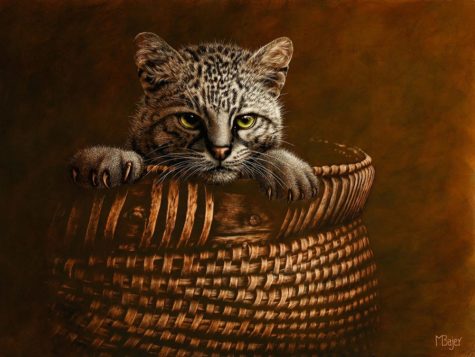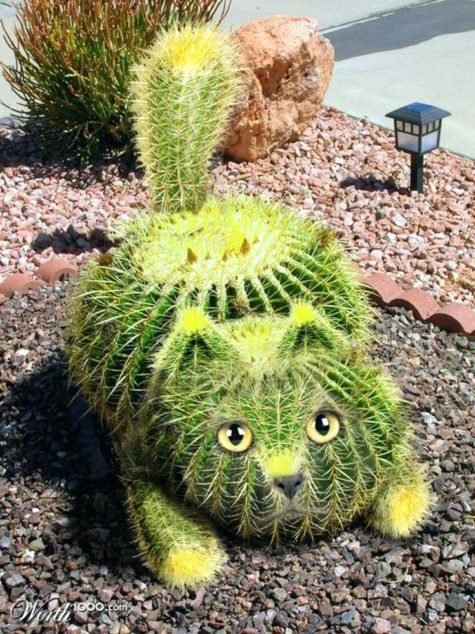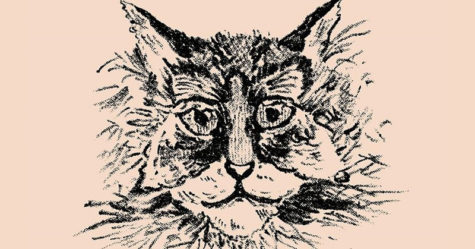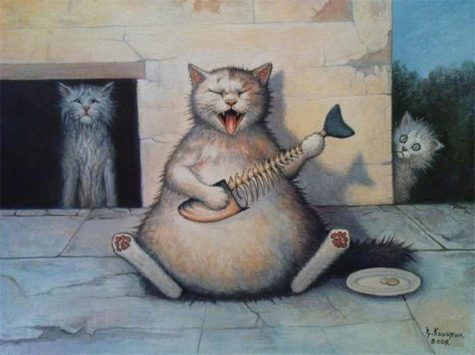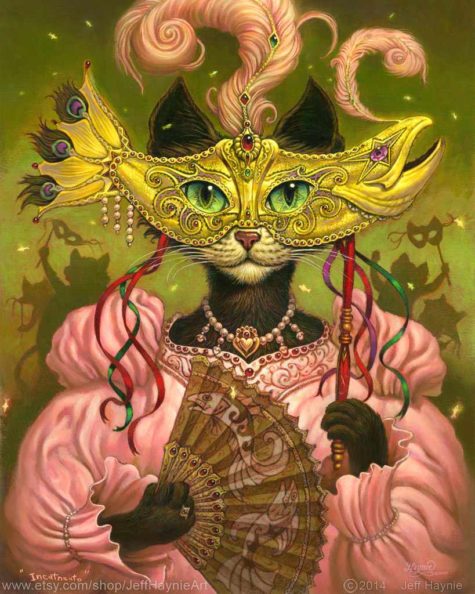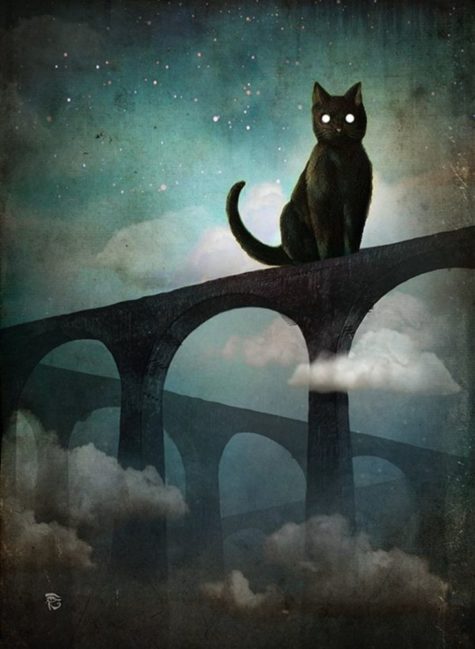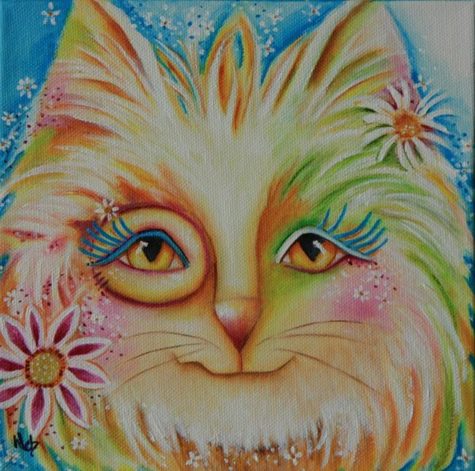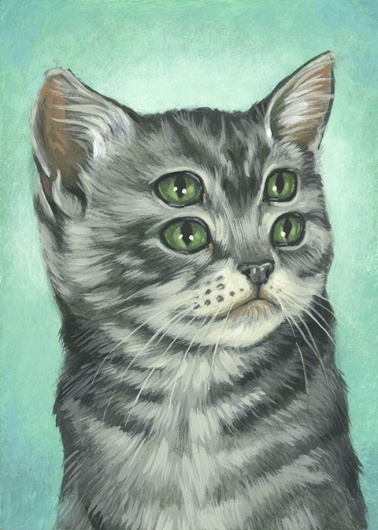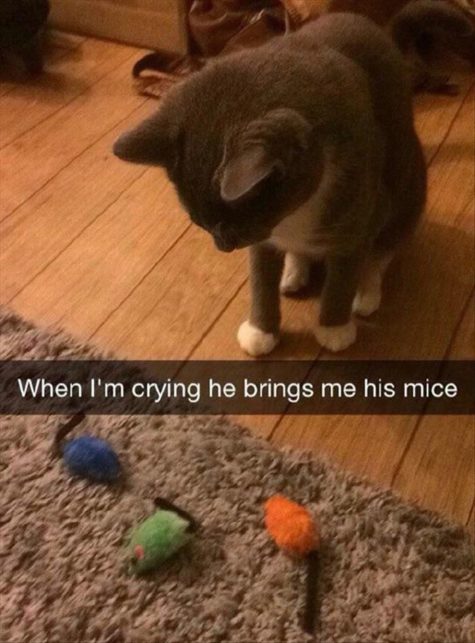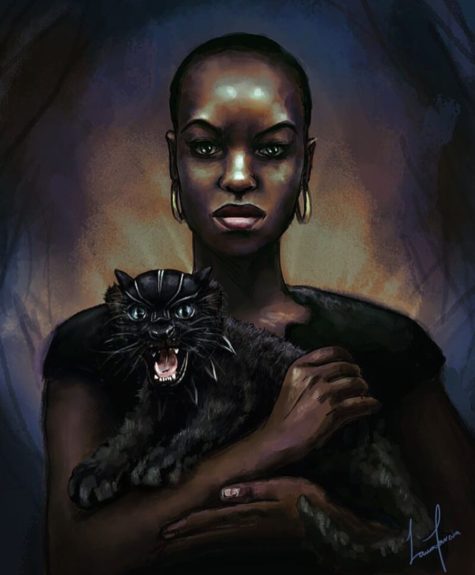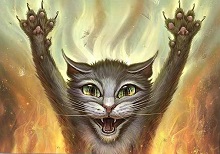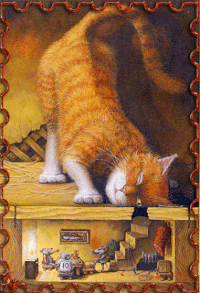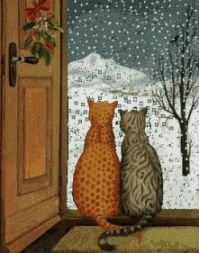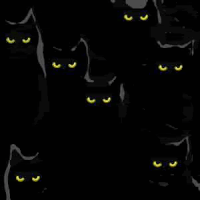Monthly Archives: June 2018
How Cats Came To Live With The Hopi
A long time ago a Hopi boy went out to hunt. It was winter and the snow lay on the ground in the valley where he searched for game. To his surprise he found some tracks in it that were like no tracks he had ever seen before, and he followed them. The tracks led out of the valley and ended at a large rock.
The boy put his hand into the opening under the rock and pulled out a strange animal by its leg. He tied its legs together and started back with it to his village. When he reached home, he asked his father what the animal was. The boy’s father replied that it was a cat and that it ate mice, rats and rabbits.
On hearing this, the boy went back into the valley and caught a rabbit which he brought back to the cat. He kept the cat confined in a niche in the wall of his home and continued to feed it for four days. In this way the cat became tame and cats have lived in Hopi houses ever since.
Found at: Moggycats Cat Pages
The Cactus Cat
By William T Cox, from “Fearsome Creatures of the Lumberwoods, with a Few Desert and Mountain Beasts,” published in 1910, we have this description of the Splinter Cat, (Cactifelinus Inebrius).
How many people have heard of the cactus cat? Thousands of people spend their winters in the great Southwest – the land of desert and mountain, of fruitful valleys, of flat-topped mesas, of Pueblos, Navajos, and Apaches, of sunshine, and the ruins of ancient “Cliff-dwellers.” It is doubtful, however, if one in a hundred of these people ever heard of a cactus cat, to say nothing of seeing one sporting about among the cholla and palo verde. Only the oldtimers know of the beast and its queer habits.
The cactus cat, as its name signifies, lives in the great cactus districts, and is particularly abundant between Prescott and Tucson. It has been reported, also, from the valley of the lower Yaqui, in Old Mexico, and the cholla-covered hills of Yucatan.
The cactus cat has thorny hair, the thorns being especially long and rigid on its ears. Its tail is branched and upon the forearms above its front feet are sharp, knifelike blades of bone. With these blades it slashes the base of giant cactus trees, causing the sap to exude. This is done systematically, many trees being slashed in the course of several nights as the cat makes a big circuit.
By the time it is back to the place of beginning, the sap of the first cactus has fermented into a kind of mescal, sweet and very intoxicating. This is greedily lapped up by the thirsty beast, which soon becomes fiddling drunk, and goes waltzing off in the moonlight, rasping its bony forearms across each other and screaming with delight.
The Splinter Cat
By William T Cox, from “Fearsome Creatures of the Lumberwoods, with a Few Desert and Mountain Beasts,” published in 1910, we have this description of the Splinter Cat, (Felynx Arbordiffisus).
A widely distributed and frightfully destructive animal is the splinter cat. It is found from the Great Lakes to the Gulf, and eastward to the Atlantic Ocean, but in the Rocky Mountains has been reported from only a few localities.
Apparently the splinter cat inhabits that part of the country in which wild bees and raccoons abound. These are its natural food, and the animal puts in every dark and stormy night shattering trees in search of coons or honey. It doesn’t use any judgement in selecting coon trees or bee trees, but just smashes one tree after another until a hollow one containing food is found.
The method used by this animal in its destructive work is simple but effective. It climbs one tree, and from the uppermost branches bounds down and across toward the tree it wishes to destroy. Striking squarely with its hard face, the splinter cat passes right on, leaving the tree broken and shattered as though struck by lightning or snapped off by the wind.
Appalling destruction has been wrought by this animal in the Gulf States, where its work in the shape of a wrecked forest is often ascribed to windstorms.
The Greedy and Ambitious Cat
There was once an old woman who lived in a village. She was half-starved, extremely thin and meager and lived a thrifty life in a dark and gloomy little cottage. This miserable creature had as her only companion a cat as wretched and lean as herself. The cat never saw bread or other people and she had to make do with trying to catch the mice that left their paw prints on the dusty floor of the miserly dwelling.
If the cat was extraordinarily lucky and managed to catch a mouse, she was like a beggar that had discovered treasure. Her face and eyes lit up with joy and she made her treasure – the mouse – last a whole week! In fact she was so admiring of her luck and so distrustful of her own happiness that she said to herself, “Is this really happening or is it just a dream?” for the old woman and the cottage were so miserly that even the mice went elsewhere.
One day, the poor cat was half-dead from starvation and she climbed up onto the roof of the cottage in the hope of finding something to eat. From there she saw a neighbor’s cat walking along the neighbor’s wall as proudly as a lion and so fat that she could hardly walk. The old woman’s cat was astonished to see one of her own kind so plump and large.
In a loud voice, the thin cat called out to her pussy neighbor, “In the name of pity, tell me where you go to get your skin so well stuffed! Why, you look as if you came from one of the Khan of Kathai’s feasts!”
The fat cat replied “Where else should one feed so well but at a king’s table? I go to the house every day about dinnertime; there I lay my paws upon some delicious morsel or other, which serves me till the next. I leave enough for an army of mice, which under me live in peace and tranquility – after all, why should I murder a tough, stringy mouse, when I can easily dine on succulent venison?”
On hearing this, the thin cat asked the way to this house of plenty and begged her plump neighbour to take her with her next time.
“Most willingly,” said the fat cat, “there is plenty for all and I am naturally charitable and you are so thin that I heartily pity your condition.”
Having made the promise, the cats parted company and the thin cat returned to the old woman’s cottage where she told the old woman about the meeting with the fat cat and the plentiful food. The old woman prudently tried to persuade her cat not to go to the house of plenty and warned her to be careful of being deceived, “Believe me, the desires of greedy and ambitious people are never satisfied until their mouths are stuffed with the dirt of their graves. Sobriety and temperance are the only things that truly enrich people.” Said the old woman, “You poor silly cat! Those who travel to satisfy their greed and ambition don’t recognise the good things they already possess. Those who aren’t contented with their lot are never truly grateful for what they do have, but always want more.”
The poor starved cat, however, was so envious of the fat cat’s good fortune and of the king’s table, that the old woman’s good morals and judicious advice went in one ear and out the other. The next day, the thin cat went with the fat cat to the king’s house.
Alas! Before the cats arrived, the king had become weary of having his food stolen or spoiled by a plague of cats. The night before, several grimalkins had robbed the king’s larder and the king had ordered his servants to kill any cats that came near.
The old woman’s cat, however, was pushed on by hunger and entered the house. She immediately saw an unattended dish of meat in the kitchen and seized it. She took the stolen meat under the dresser and, for the first time in years, she filled her lean belly with good food. As she was enjoying the feast, one of the kitchen overseers found his breakfast had gone missing. Seeing the cat eating the stolen breakfast, he threw a knife at the poor creature. Unluckily for the cat, the knife struck her full in the breast.
However, nature had given the cat nine lives instead of one, and the poor puss feigned being dead until the overseer left. She then began to crawl away. Seeing her own blood flowing freely from her breast, the poor cat pledged “Just let me escape this mishap and should I ever become discontent with my own home and my own mice and come looking for morsels from the king’s kitchen then may i lose all of my nine lives at once!”
By Pilpay, an Oriental author circa 300 BC
The Cat Maiden
The gods disagreed on whether it was possible for a living being to change its nature. Jupiter claimed it was possible, but Venus argued that it was impossible. To test the issue, Jupiter transformed a cat into a maiden, and gave her to a young man for a wife. The wedding was duly performed and the young couple sat down to their wedding-feast.
Jupiter said to Venus, “See how becomingly she behaves. Who could tell that yesterday she was a cat? Surely her nature is changed.” Venus responded by letting a mouse loose in the room. When the bride saw the mouse, she jumped up from her seat and tried to pounce on it. Venus then replied, “You see – nothing can change one’s real nature.”
~Aesop
The Lays of Tom-Cat Hiddigeigei
Part I
When through valley and o’er mountain
Howls the storm at dead of night,
Clambering over roof and chimney,
Hiddigeigei seeks the height,
Spectre-like aloft he stands there,
Fairer than he ever seems;
From his eyes the fire-flame sparkles,
From his bristling hair it streams.
And he lifts his voice, and wildly
Sings an old cat-battle song,
That, like far-off thunder rolling,
Sweeps the storm-vexed night along.
Never a child of man can hear it –
Each sleeps heedless in his house;
But, deep down in darkest cellar,
Hears, and paling, quakes the mouse.
Well she knows the greybeard’s war-cry,
Knows the cry she trembles at,
Feels how fearful in his fury
Is the grand old hero-cat.
Part II
From the tower’s topmost angle
On the world I turn my eyes –
Mark, serene, the factions wrangle,
And the parties fall and rise.
And the keen cat’s eyes they see there –
And the cat’s soul feels the joke—
What dull pranks they cut beneath there,
All those petty pigmy-folk.
But what use? For I can’t make ‘em
See things from my point of view;
Even should the devil take ‘em,
‘Twill but be the devil’s due.
Human nature! who can bear it?
Crooked ways and wicked wiles!
Wrapped in consciousness of merit,
Sits the tom-cat on the tiles!
~By Joseph Victor Von Scheffel,
(from Der Tromp eter von Sakkingen, 1880, translated from German).
An Ancient Chinese Cat Myth
When the world was a new-created place, the gods decided to appoint one creature to see that it ran smoothly and to oversee all other creatures. The creature they selected was the cat. Thoughtful and contemplative, cats were given the power of speech in order to talk with the creator gods and give instructions to the other creatures who shared the world. For a long time all seemed to go well.
Cats, however, were sybaritic creatures. Rather than attend to the mundane, day-to-day running of a world, they wanted to doze in sunbeams on beds of fragrant catnip and matatabi vine. The creator gods saw this and asked the cats whether they were doing anything to ensure the smooth running of this newly made world.
“Running a world is not of great interest to us,” said the cats, “we are content to roll on the grass and chase butterflies when the mood takes us. Mostly we let the world run itself so that we can enjoy the simple pleasures of warm sunshine and fresh, scented air.”
The gods asked the cats to be more diligent in the running of the newly made world and the cats promised to pay a little more attention to their allotted task. Some while later, the gods paid another visit to their vibrant new world and they found the cats sleeping under cherry trees or playing with falling cherry blossoms. Once more they questioned the cats’ dedication to overseeing the world.
“Running a world is, to be honest, a rather boring task. It is much more fun to sleep comfortably under cherry trees and frolic among the falling blossom,” said the cats, “however, we will try to pay more attention to the business of being in charge of the world – it is a great responsibility.”
The gods chastised the cats a second time and went away full of hope that the cats would pay closer attention to the running of the world the gods had given them. However, on a third visit, the gods found the cats chasing floating thistledown in the late summer sunshine.
“To be perfectly honest,” the cats said, “we’ve realised that we really don’t want the bother of running a world. We’ve noticed that one of your creatures shows much more promise in this respect, perhaps you could give the task of running a world to them so that we can spend our time enjoying the pleasures this world has to offer.”
The gods reluctantly agreed, but on one condition. Those appointed to run the world required the power of speech. Therefore cats would no longer be able to talk and the other creature, called humans, would be endowed with speech. And while man busied himself about running the world and remaking it to his own liking and filling it with chatter, cats basked in scented sunshine with inscrutable expressions.
From that day on, mankind gained the power of speech while cats enjoyed the delights the world had to offer – sunshine, scents, textures and things to chase or play with. But the gods never forgot that the cat was their first chosen one to run the world and made them timekeepers so that humans could always tell the time of day by looking into a cat’s eyes. In the morning their eyes are pools of blackness rimmed with gold; at noon they are mere black slits on disks of gold while in the evening they open out into pools of blackness once more.
Not only that, the purring of the cat is the sound of the machinery moving the world around the heavens and should the cats cease to purr, the world would stand still in the sky and the seasons, and all of time, would come to an end. So while mankind has the day-to-day running of the world, the cat still remains its timekeeper and guardian which is why cats always look so inscrutable and so smug.
Found at: Moggycats Cat Pages
The Four Eyed Cat
It was once generally believed by British fishermen that it is unlucky to take a woman to the fishing grounds, allow a woman onto a fishing boat or even to meet a woman on the way to sea. In some places this taboo extends even to mentioning a woman. This superstition persists in a few areas.
Once there was a gentleman had a beautiful daughter who was bad at heart. It was said that she knew more than a Christian ought and the people thereabouts wanted to swim her. This meant they wanted to test her as a suspected witch by casting her into the water to see if she floated – if she floated it was proof she was a witch, if she sank then she was innocent.
However, no one dared swim the suspected witch because of her father. The girl put a spell on a poor fisherman, and he became so in love with her that he followed her wherever she went. Even though he was engaged to be married that week, he deserted his bride-to-be and ran away to see with the gentleman’s daughter. She did this to spite her proud father, but her father thought himself well rid of the spiteful maid.
The fishermen unwittingly took her out with them to the fishing grounds; the only one that knew she was in a fishing boat was her lover who had hidden there. A great storm blew up and the whole fishing fleet were lost and every man drowned. It was said that she had whistled up the storm. She had even drowned her own lover out of spitefulness. Afterwards, she turned into a four-eyed cat and she continued to haunt the fishing fleet. This is why fishermen will never cast their nets before cock-crow (half-past three) and why they always throw a bit back into the sea to appease the cat.
Found at: Moggycats Cat Pages
Kitty Comfort
African Cat Gods and Lore
Africa has cats. We all know that. The problem is that most of the cats of Africa can rip you to shreds without so much as an “if-you-please.” Sure, Egypt and their adored cats were in Africa, but that culture was radically different from those of the remarkably diverse peoples inhabiting the rest of this vast continent.
Big and dangerous cats were everywhere, and I would think that dealing with them would be precarious at best. For instance, imagine how scratched up you can get when performing the marginally difficult task of giving your cat a bath. Now imagine if that cat weighed about 400 pounds like the African Lion. And lions aren’t the only big African cats; don’t forget cheetahs and leopards.
Fortunately, these magnificent creatures usually won’t harm humans unless they are starving or terrified. The indigenous people of Africa have nothing but the respect for these big-cats (and indeed all animals) and their ancient myths and legends are filled with the exploits of these creatures.
But there was one African cat that wasn’t so big. To the Africans it was just another cat, albeit, a smaller one. We’ve given it the scientific name Felis Libyca or simply the African wildcat. Around 4497 years ago (c.3000 B.C. ) this wildcat made its way through Ethiopia and up into Egypt. These are believed to be the very cats that the Egyptians domesticated.
While we’re on the subject, the cat we all know and love today is descended from the pairing of the African wildcat Felis Libyca and the European wildcat Felis Silvestris, (do you suppose this where the cartoon Sylvester got his name?) And just in case you are burning with curiosity, that adorable pussycat all snuggled nicely in your lap is designated Felis Catus.
So next time you happen to be studying the behavior of your cat, remember its rich African heritage. And if you are looking for an interesting and unusual magickal name for your cat, you might consider the following:
- AGASSOU (Ah-Gahs’-Oo) Panther Fetish of the Dahomey tribes. Male or Female:
Dahomey (now called Benin), is a country along the West Central coast of Africa, founded by the Yoruba tribe of Ife in the 12th century. Over time this region was settled by people known as the Edo and the Fon. Within this rather small district, four kingdoms arose, the mightiest of which was Abomey. Dahomey was well known for its fine craftsmanship, being particularly adept in ivory sculpture. A walled city said to be 25 miles in circumference, Dahomey was one of the magnificent jewels of African civilization. Now Agassou wasn’t a god but a fetish, which means an object empowered by spiritual forces. Since the Panther was considered a creature of great power and courage, the figure of Agassou the Panther was assigned as guardian and protector to the king (called the Oba.)
- AKONGO (Ah-Kong’-Go) Male:
There are those cats which enjoy the company of humans and then there are those that do not. If your cat is one of the kind that despises the formalities of social interaction, then listen to this tale from the Ngombe tribe of the Congo. Akongo was the Supreme god.
Being a benevolent, easy going deity he chose to live upon the earth with humanity because he enjoyed working and relaxing alongside them. But things began to grow sour. The humans began complaining and bickering about the most trivial of things. They became more and more self-centered, selfish, greedy and covetous. Where they once enjoyed idyllic pleasures during their time of leisure, they now filled those moments with drunken revelry and obnoxious behavior. Then one day, two of the humans attacked each other.
A violent battle ensued which so disgusted the god Akongo that he left humanity to themselves. He was said to have disappeared into the depths of the jungle, determined to never again associate with people. It is said that he has not been seen since. So if you know of a cat like this, antisocial and preferring solitude, remember the name Akongo.
- AMMA (Ah’-Mah) Male:
This is the Supreme god of the Dogon tribe of Mali. He was something of a misogynist actually, so here’s a name for a neutered cat that really couldn’t care less about females. Why was Amma such a misogynist? Well, being the supreme god, naturally he created the world and the universe. They say he created the stars by tossing dirt clods into the sky.
Next, he decided that he would create a woman so he could breed. He made this woman, also from clay. She was the earth. But one thing bothered Amma. Upon the surface of the newly formed earth grew a termite mound. This was in fact her clitoris. Fearing that this might prove to be a sign of a competing masculinity, the god had it severed, believing that in doing so he would make her 100% woman.
An awful story, I know, but to this day some African peoples still practice a form of female circumcision called clitoridectomy. Whether or not this has anything to do with the myth is uncertain.
- ANANSI (Ah-Nahn’-See) Male:
To the Ashanti culture he is one of the most important heroes and is the primary character in many of their myths. Even though you may not have heard of this god, there is one tale about him with which I’m sure you’re familiar.
It’s a rather long, complicated story, but the gist of it is Anansi must gather several items for the sky god Nyankopon. This he does in his prank-laden style. The last item he had to collect was a nature spirit, most elusive elementals indeed. Of course Anansi had a plan. He molded a figure of a person out of an extremely sticky resin and placed it on a rock where he knew the nature spirits often passed. Near the figure he placed a dish of food.
Before long, one of these nature elementals came by and noticed the food. The spirit asked if it could have a taste, but naturally the figure did not reply. Thinking the “person” was being disrespectful and rude, the elemental slugged the figure as hard as he could. Much to his surprise, his hand became caught in the resin. Panicking, the spirit hit the figure with his free hand and then kicked it and finally butted it with its head. With each movement the spirit became more and more stuck in the gooey tree sap until he was absolutely unable to move.
At this point Anansi approached the hopelessly trapped elemental and placed him in a sack to make his delivery. If you haven’t recognized the story by now, then you’ve never heard any of the American folk tales attributed to a fictional slave named “Uncle Remus.” This African legend is in fact the source for the story of Brer Rabbit and the tar baby. Since many cats are known for their mischievous antics and behavior that might even be construed as deliberate pranks, keep the name Anansi in mind.
- BUMBA (Boom’-Bah) Male:
Cats will at sometime in their lives throw up hair balls. No big deal, it’s just a fact of feline existence. If your cat seems to be hacking them up continuously, then this god name with its odd little tale might be appropriate.
Bumba is another one of those creator gods, this time of the Bushongo people of the Congo. How this god created the world is disgusting to say the least since he vomited up the stars, the sun, the moon, everything in fact. He then created (or vomited) Heaven and Earth who were supposed to live together as a married couple. Things didn’t work out and Heaven decided to leave for good. They have been divided ever since. Reunification is only possible when the material Earth ceases, which actually means when WE cease.
- FAMIEN (Fah’-Meen) Male:
Cats are often associated with witches and wizards and such. Some say that the reason for this is due to their unique ability to absorb evil influences and repel negative energies. Perhaps you’ve discovered this feline trait yourself through observing the protective behavior of your own cat.
If so, then Famien might be just the name for your guardian mouser. Famien was the fertility god of Guinea, but besides that he was also the preeminent luminary against demons and dark sorcerers. If that wasn’t enough, he was also the supreme lord of good health. A name that resonates with favorable luck.
- GUNAB (Goo’-Nab) Male:
For some reason this god of the Hottentot was considered an evil force, even though he is said to have created the rainbow. He was known to make dark rock quarries his domicile, so maybe if your cat likes dark hiding places this would make a suitable name.
- GURUHI (Goo-Roo’-Hee) Male:
Here’s an appropriate name for a spoiled and moody cat, prone to insisting upon selfish demands. Guruhi is another evil god, this time from Gambia. He was a most demanding and vengeful god. However, to his worshipers he bestowed great powers, providing they offered him the right kind of blood sacrifice, that is. Those uninitiated to his cult were forbidden even to gaze upon him, and Guruhi took great delight in torturing those foolish enough to ignore this rule.
- HEVIOSSO (Heh-Vee-Oh’-So) Male:
There are some cats that are content to simply relax in the window sill enjoying the sunshine. Then there are the cats that have to tear apart everything in sight, sparing neither couch nor curtain from their razor sharp claws. If this sounds familiar to you, you may consider naming your destructive kitty after the Dahomey god of thunder, Heviosso.
Besides the usual chaotic attributes which you would expect to accompany a thunder god, there is a very curious ritual performed in his honor by troupes of ceremonial dancers that explains why this name fits a ruinous kitty so well.
During his rites, the dancers of Heviosso make thunder-noises while engaging in wild movements representing the thunder god’s sexual union with the earth. These dancers froth themselves up into such turmoil that they begin wrecking everything and anything including their own homes. They tear apart bushes and vegetation. They assault innocent spectators. They’ve even been known to raze the various sacred sites to the ground. And just think, all this could be avoided if only they had a really big scratching post.
- KALUMBA (Kah-Loom’-Bah) Male:
Kalumba was the god of creation to the Luba tribe of Zaire. Cat fanciers can appreciate one story concerning this god, if only because it makes dogs look so stupid. As the tale goes, Kalumba noticed the forces of Life and Death, casually strolling down a dirt path toward the world of the creatures called men whom he had only recently created. To insure that his creations would be allowed to flourish, Kalumba posted Dog and Goat in the middle of the road with orders to let Life pass while apprehending Death.
Once Goat and Dog were in place, they started bickering about which one of them would do the best job by staying awake the longest. Goat left Dog alone, just out of spite. So, all alone, Dog did his best to keep a vigilant watch, but to no avail. Dog fell sound asleep and while deep in slumber, Death walked right on by and entered the world of man.
Well, the next day Goat returned to relieve Dog who quickly departed in shame. Determined not to be as foolish as Dog, Goat forced himself to stay wide awake. Eventually he spotted Life coming on down the road and promptly detained him. Thus it was that Life was prevented from passing to the world of men, giving Death free reign. Of course things would have been a lot different had Kalumba posted cats on that road. Especially if they were BIG cats.
- KOKOLA (Koh-Koh-Lah’) Male:
This god was supposed to keep watch over precious items and valued possessions. Legends say that he lived in a cave near the banks of Lake Victoria. It was to this cave that various articles in need of protection were brought, kind of like a rock-hewn safety deposit vault.
Now I’m sure we all know of a cat that is a bit overprotective of one thing or another. It could be a particular food-dish, a treasured catnip toy, or even a favorite place to sit. By exhibiting such behavior, the cat may very well be imitating some trace remnant of Kokola’s guardian tendencies.
- KYALA (Kye-Ah’-Lah) Male:
This is the creator god to the Nyakyusa tribe of Tanzania. He started off as a simple provincial god then made his way up to the king-sky god. He became so vainglorious as a result of his rise to power that he demanded an instant cessation in devotions from those who worshipped him. He decided that he was just too significant to be dealing with trivial little creatures like humans. Got a stuck-up feline who thinks his litter box doesn’t stink? Then here’s the consummate name.
- LEGBA (Leg’-Bah) Male:
Keep in mind, Legba is considered an evil god by the Dahomey. You may recognize his name if you are familiar with the practice of voudon or voodoo, for this African god was the original form which was later adopted by the Haitians. Evil god that he was, the Africans still paid him homage by offering preventative sacrifices more or less as a means of keeping him away. These sacrifices were often small goats, usually offered during the rites to HEVIOSSO.
Legba was also represented by small clay figurines which every tribe member kept near their home. These figures were tended to regularly by offering food and often a sacrificed chicken in an effort to satiate the dark god. I only include this name because, after all, not everyone’s cat is a saint.
- LISA (Lee’-Sah) Female:
Finally, a female name for a change. Lisa (also known as Leza or Lissa) is the chameleon god of the Dahomey. She is often associated with the chief god MAWU. Together with their son Ge (god of the moon), they form one of the many triads found in mythologies the world over. Actually, Lisa could be either a god or a goddess–something of a divine androgen. In her female state she is considered goddess of chameleons because it is told that she sent these creatures as helpmates to those humans engaged in expanding her sect.
With that in mind, I can think of two situations where one might name their cat after this chameleon goddess. First, since calico cats are a virtual potpourri of colors, the chameleon motif works nicely. Then there are those cats with fluctuating behavioral patterns that range from moody to content to wild back to moody again.
If you pay close attention, you might find that your cat is merely reflecting your own state of mind. If so, then this goddess’s common sounding name would truly fit the chameleon-like traits of your uncommon cat.
- MAWU (Mah’-Woo) Male:
We’ve already touched on Mawu and his relationship with the androgynous LISA, but it should be pointed out that he has a bit of an androgynous nature himself. To some of the Dahomey tribes Mawu remains the chief of the gods, but some tribes in West Africa consider Mawu to be the goddess of the moon. Then too, the Dahomey tribes often unify Mawu and Lisa into a male/female god named, oddly enough, Mawu-Lisa, the progenitor of all Dahomey gods.
Regardless, he is most often thought of as the creator. With Lisa and their son Ge, they form an important triad not unlike that of Egypt’s ISIS, OSIRIS, and HORUS. All this can be confusing enough as it is, so let’s leave out the part where Mawu (the moon goddess version) gives birth to a male form of Lisa (now considered a sun god) to form a unified King of the Gods. Here’s a good name for a sexually ambivalent cat, male or female. Besides, don’t you think Mawu sounds kind of like “meow”?
- MULUKU (Muh-Loo’-Koo) Male:
Another Supreme god, this time from Zambesi. The story goes that after making the earth, Muluku decided to dig two holes deep into the newly created soil. Soon a human male crawled out of one hole, while out of the other hole climbed a human female.
Right away, Muluku set to organizing these new creatures by providing them with tools and seeds with which they might begin to cultivate the land. He gave them instructions on using the tools and on the various seeds to plant. He showed them how they might build shelter and how they were to prepare the harvests which the seeds would soon yield.
Unfortunately none of this seemed to mean much to the new humans. They ate the seeds raw, tossed the tools all about making a big mess and then headed off toward the forest where they both hid in the trees. Needless to say, this irked the god to no end. As an experiment Muluku called two monkeys, a male and a female, and just for kicks gave them identical tools, seeds and instructions.
Well, the monkeys wasted no time. They planted, they worked, they built their shelters, and in time they harvested the food and even used a few of the recipes that Muluku had so thoughtfully suggested. Learning what he had set out to discover, the god knew just what his next move would be. Cutting off the tails of his two monkey friends, Muluku quickly attached them to the two foolish humans still hiding in the trees.
So it was that the original humans became monkeys and the original monkeys became humans. There is a very important message in this whimsical legend, though I have no idea what it is. Since Muluku was both a creator god and a harvest god, this name might suit a country-cat, at home in the corn and the wheat. If not, well then you’re on your own with this one.
- MUNGO (Muhn’-Goh) Male:
Here is a name that recalls the cat “Mungojerry” of T.S. Eliot fame. Actually, Mungo was the rain god of the Giryama of Kenya. To get him to send rain, what you do is sacrifice a goat along with a chicken, beat on the horn of a water buffalo while asking Mungo to send precipitation, then tie a white sheet to the roof of your house. As if through a miracle, it will begin raining! Well, eventually anyhow. Name your cat Mungo if he happens to love staring out the window on dark and drizzly days.
- NAMPA (Nahm’-Pah) Male:
Does your cat have a problem with hairballs? What cat doesn’t? Of course some cats have more of a problem than others, so if your kitty happens to be one of those chronic hairball types, Nampa may be just the name for you.
Nampa was more of a spirit than a god. To the people of Senegal he is represented as a fetish composed of pulped roots and leaves which are then, you guessed it, rolled into little balls. That’s about all the information I could get on him since only the elite get to worship him and that they do in utmost secrecy.
- NYAMBE (Nigh-Ahm’-Bee) Male:
There are actually two gods with this same name or a variation of it (Nyambi.) One is the Nyambe of the Koko tribe in Nigeria. To the Koko, he was the god of regeneration. He lived on the earth with humans and provided them with immortality through the agency of one very special, life-giving tree. But the people began to take this beneficent god for granted. This hurt Nyambe very much.
One day he called the people to gather around. When they had assembled, the god took a bundle of twigs and asked if any man was strong enough to break them. Many tried that day, but no one succeeded. Nyambe then pointed out that when the twigs were released from the bundle, they broke quite easily. He explained that when they had bound themselves to him, they had strength and nothing could take that from them, but now that they distanced themselves from him, they were alone and weak. With that, Nyambe pulled the tree of immortality from the ground and disappeared forever. It wasn’t long after this that people began to die.
The other Nyambe hails from the Barotse tribe of Upper Zambesi. His tale is interesting in that it is one of many African legends which, from tribe to tribe, speak of man’s foolishness in attempting to reach god by constructing a tower to the heavens. Sound familiar?
Anyway, this legend reads more like an old Warner Brother’s cartoon, with Nyambe being chased around the globe by a whining human named Kamonu. Kamonu was full of petty requests which the god always fulfilled. Then one day, the god had reached his limit. Unfortunately, that was the day that Kamonu’s child died.
For the first time the god’s help was needed for something really important, so Kamonu tracked Nyambe down and begged his assistance. But the god wouldn’t listen and ran away into the forest. No sooner had Nyambe settled down in the forest than he noticed Kamonu only a few steps away. The god ran off to a secluded cave, where, who should be waiting for him but Kamonu. Nyambe, stunned by the sight, ran to the top of the world’s highest mountain only to find Kamonu there already. Eventually Nyambe was able to get completely away.
Undaunted, the indefatigable Kamonu built himself a tower just as high as he possibly could. It is said that Kamonu sits upon his tower to this very day, greeting the sun and the moon as they make their passage across the sky, and that he shall continue to sit there for all eternity, hoping one day he will be allowed to see Nyambe again. In both stories you’ll notice the god’s desire to shun human society, so consider that should you be trying to think of the right name for an adopted feral cat.
- NZAMBI (Nah-Zahm’-Bee) Female:
Another female! Nzambi was the great goddess of creation to the Bakongo tribe of the Congo. She was said to have walked the world of men disguised as a filthy old beggar woman, pleading for help wherever she went. To those who assisted her she gave great rewards. However, those who offered her nothing but scorn were severely punished and learned a very hard lesson about charity. This is only one example of her style. She was known for bestowing grace or scrutiny to individuals based upon their virtues or faults, respectively. A fitting name for one of those slovenly street cats that turn out to be much more than they might have at first appeared.
- OGUN (Oh’-Guhn) Male:
The West African tribes of the Nago and Yoruba recognize Ogun as the god of iron and warfare. Since he is the god of iron, he is the patron of forgemen and metalworkers. It makes sense then that he is also the god of war when you consider the weaponry crafted by these artisans. As for Ogun himself, his weapon of choice is the machete.
This god and his machete have become symbols of clearing away difficulties, and to this end they are often evoked. This is the result of a story wherein the legendary gods first come to the earth, only to find the entire planet covered with dense thorn bushes and other barriers of wild vegetation. Rising to the occasion, Ogun used his machete to cut a pathway for his fellow deities.
Since then he has been called upon to lend his helping hand by those seeking assistance in achieving their goals. Perhaps this is also how he got his reputation as a war god. As a cat name Ogun might be good for a fighting tom, but on a more civilized note you might give this name to an emotionally beneficial cat.
- OMUMBO-ROMBONGA (Oh-Muhm’-Boh Rohm-Bong’-Gah) Male or Female:
This name doesn’t belong to a god, a devil, or even a spirit. This is the name of the tree from which all human beings were born, according to the Herero Bushmen of South West Africa. It is also the source from which many other animals originated. Because of this, it is believed that humans and animals once spoke a common language having been born from the same tree. Sadly, this language has been long forgotten by human beings. Omumbo-Rombonga is a lot easier to pronounce than it may look and makes a great name for tree-loving cats of either sex.
- RUWA (Roo’-Wah) Male:
Sometimes myths from vastly diverse cultures share common details and motifs as in the following story from the Djaga tribe of Kilimanjaro. Ruwa was the supreme god, though he had more to do with the management of creation than with actually creating it.
He had recently freed the humans from that big pot where they had been kept prisoner and now he was preparing a garden where they could live in peace. He filled this garden with all sorts of fruit bearing trees, and in the middle he placed a sacred yam which was forbidden to the humans.
Everything went just fine for a long time, but then one day an odd looking beggar came to the garden in search of food. He was offered as much of the garden’s fruits as he wished, but he claimed to have met Ruwa on the way to the garden and said that the god had told him it was time to eat the sacred yam. Without a moment’s hesitation the people pulled that yam from the middle of the garden and began to cook it with great celebration.
Soon the scent of the yam filled the air, and it wasn’t long before the smell reached heaven. Catching a slight whiff of the forbidden yam, Ruwa dashed down to the garden. There he saw the humans whooping it up, doing exactly what he had told them not to do. The god was understandably upset, especially since the word of a stranger had been followed rather than his own explicit orders.
Taking what was left of his sacred yam, Ruwa went back to heaven leaving the humans with a new susceptibility to something called death. Nothing particularly cat-like seems to be in this interesting tale, but has that ever stopped us before from finding some half-baked reason to use a name for your cat? Of course not! Use this name for an arbitrarily demanding feline with very little sense of humor.
- SHANGO (Shahn’-Goh) Male:
To the Yoruba of West Africa, Shango is the god of storms, thunder, and lightning. He carries a thunderbolt which is often symbolically rendered as an ax. In this regard he is very close to the Nordic god Thor. A good name for an extremely sharp, lightning fast cat with a volatile personality.
- WAKA (Wah’-Kah) Male:
Another rain god. But to the Galla of Ethiopia, Waka is much more than a rain god. He is also the god of rituals and ceremony. Keep this name in mind if your cat is of an ordered, mystic nature.
- WULBARI (Wool-Bahr’-Ee) Male:
Supreme god of the Krachi from West Africa. There is an odd story concerning this eccentric deity and the trickster god ANANSI. Among the animals invited to dwell in the heavenly court was Anansi, the tricky spider god. Being something of a braggart, Anansi started getting on Wulbari’s nerves. He boasted that he was much more clever than the supreme god.
To Wulbari, this just wouldn’t do. One evening the mighty god summoned the various animals to witness the presentation of a challenge to Anansi. If the trickster god could simply leave heaven for awhile and return with “something” then Wulbari would concede that the trickster god was indeed far more clever than he. There was a catch however. Wulbari wouldn’t say what the “something” was.
Accepting the challenge, Anansi left the court and promptly constructed himself a bird-suit disguise from various feathers he collected. Wulbari himself, so certain that Anansi was far away by now, blurted out that the “something” he was thinking of was the Sun, the Moon and total darkness.
Anansi, hearing this while disguised as a bird ,now knew exactly what the “something” was. Anansi came back with a sack and upon its opening, out escaped total darkness. Unable to see a thing, the other creatures fumbled about in complete chaos. Then the trickster god opened the sack again and released the Moon. That was slightly better. At least now there was a dim light in the sky. But then without warning, Anansi pulled out the brilliant Sun. This stunned everyone since their eyes had adjusted to the soft light of the Moon.
Many of the animals present were blinded by this surprise, and Wulbari was forced to admit that the trickster god had won the challenge. This tale is supposed to explain how blindness came into the world, so if you are the unfortunate owner of a blind cat (it does happen you know), then I guess this name might be appropriate. But since we all know how well cats maneuver in darkness, I think you can name any cat Wulbari in commemoration of this unusual incident.
Found at: Lowchen’s Australia
